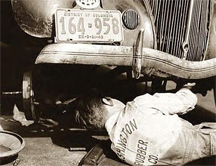 Editors of technical journals gratefully invite freelance writers to write tech-related articles for their educated readers. For the past two years I have been marketing articles to automobile publications. I find time to write during my limited periods of idleness of running a busy medical clinic in Georgia. I have found writing for trade publications to pay fairly good, up to .50 cents per word. I also enjoy the playful process of researching and writing because I educate myself on writing many other topics about cars.
Editors of technical journals gratefully invite freelance writers to write tech-related articles for their educated readers. For the past two years I have been marketing articles to automobile publications. I find time to write during my limited periods of idleness of running a busy medical clinic in Georgia. I have found writing for trade publications to pay fairly good, up to .50 cents per word. I also enjoy the playful process of researching and writing because I educate myself on writing many other topics about cars.
Some trade journals prefer journalistic-style material, which include writing news about trade organizations and companies, as well as bankruptcies or reorganizations of older corporations. Other trade journals favor illustrated articles describing new cars or new accessories or parts, as well as records of races, detailed specifications of racing cars, tracks, etc. I’ve sold articles describing auto shows, and how-to articles aimed at general readers who are car enthusiasts.
Marketing motor articles to trade journals requires substantial discrimination
—probably like most other technical articles—because no two publications are precisely alike.
 One trade journal, to which I contribute a monthly column, welcomes articles more colored by the ingredient of personality. Based on readers’
One trade journal, to which I contribute a monthly column, welcomes articles more colored by the ingredient of personality. Based on readers’
interests, the editor prefers descriptions of personal tours, as well as general touring routes with maps and detailed information. It solicits short, personal reminiscences of travel and lifestyle experiences. It also publishes terse descriptions of mechanical short cuts, and original methods of operations or maintenance, etc. Many editors expect the freelance writer to provide photographs or illustrations, either isolated or in close relation to the article.
One requisite to break into this market is you must write with accuracy.
Editors demand accuracy in all technical contributions. Most, if not all, freelance submissions go through a peer-to-peer review and, if deemed necessary, the editorial board or engineering staff will scrutinize every detail in your article. Facts, quotes, original suggestions and accuracy are demanded far above any “fine writing.” This magazine to which I contribute regularly pays on publication, and at the rate of .40 cents per word.
Another excellent market is The Motor magazine, which is distributed to automotive repair specialists. This is published by the Hearst Corporation. It buys semi-technical articles
covering any subject about repair and maintenance of cars and light trucks, domestic and imports. The editors usually need articles that help their readers (mostly shop owners) learn to service and repair old and new vehicles.
 You can find other publications with a much wider interest in automobiles. Typically editors of auto magazines will accept outside freelance submissions if they are copiously illustrated by photographs or by illustrative tables and charts, etc.
You can find other publications with a much wider interest in automobiles. Typically editors of auto magazines will accept outside freelance submissions if they are copiously illustrated by photographs or by illustrative tables and charts, etc.
Editors usually prefer articles and photographs dealing with the direct relation of roadways to automobiles.
A more likely chance to break into such publications is to pitch a descriptive article about new cars (even concept cars), accompanied with photographs and interviews.
Aside from the publications avowedly “automotive,” you can find other technical publications which use certain types of automobile and aviation articles. These magazines utilize many photographs with or without explanatory articles. Think Scientific American magazine, Popular Mechanics, and even Popular Science magazine.
For the writer who is mechanically inclined, who understands this subject, he can convince editors to review articles on spec or send a timely query letter to sell an article or write a regular column.
Several months ago I had a small article published in one of the car mechanics trade magazines. It was read by the professor of an engineering extension course which is offered by a community college in North Carolina. The purpose of the three month course is to educate first year college students enrolled in mechanical engineering about automotive care, maintenance, troubleshooting, and operation of machinery.
This professor asked me to prepare a course module for next semester. In preparing this course module, I came up with another article almost instantly. This article, relating to the current economics of automotive technology, was sold to Autoweek magazine for $300. My continued work on the training module helped me come up with additional articles, which I have also sold.
 The continual demands of my career as a medical practitioner prohibits me from writing consistently and steadily, but the articles which I’ve sold has netted me over $3,350 in the past year—a sum sufficient to pay for a trip to last year’s North American International Auto Show, as well as to other races, auto shows, and for the maintenance of my car.
The continual demands of my career as a medical practitioner prohibits me from writing consistently and steadily, but the articles which I’ve sold has netted me over $3,350 in the past year—a sum sufficient to pay for a trip to last year’s North American International Auto Show, as well as to other races, auto shows, and for the maintenance of my car.



